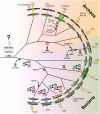Evolution of a family of molecular Rube Goldberg contraptions
- PMID: 31415567
- PMCID: PMC6711533
- DOI: 10.1371/journal.pbio.3000405
Evolution of a family of molecular Rube Goldberg contraptions
Abstract
Case studies of the evolution of molecular machines remain scarce. One of the most diverse and widespread homologous families of machines is the type IV filament (TFF) superfamily, comprised of type IV pili, type II secretion systems (T2SSs), archaella, and other less-well-characterized families. These families have functions including twitching motility, effector export, rotary propulsion, nutrient uptake, DNA uptake, and even electrical conductance, but it is unclear how such diversity evolved from a common ancestor. In this issue, Denise and colleagues take a significant step toward understanding evolution of the TFF superfamily by determining a global phylogeny and using it to infer an evolutionary pathway. Results reveal that the superfamily predates the divergence of Bacteria and Archaea, and show how duplications, acquisitions, and losses coincide with changes in function. Surprises include that tight adherence (Tad) pili were horizontally acquired from Archaea and that T2SSs were relatively recently repurposed from type IV pili. Results also enable better understanding of the function of the ATPase family that powers the superfamily. The study highlights the role of tinkering by exaptation-the repurposing of pre-existing functions for new roles-in the diversification of molecular machines.
Conflict of interest statement
The authors have declared that no competing interests exist.
Figures

Comment on
-
Diversification of the type IV filament superfamily into machines for adhesion, protein secretion, DNA uptake, and motility.PLoS Biol. 2019 Jul 19;17(7):e3000390. doi: 10.1371/journal.pbio.3000390. eCollection 2019 Jul. PLoS Biol. 2019. PMID: 31323028 Free PMC article.
References
-
- Gould SJ, Vrba ES. Exaptation-A Missing Term in the Science of Form. Paleobiology. 1982;8: 4–15.
-
- Kauffman SA. Investigations. Oxford, New York: Oxford University Press; 2003.
Publication types
MeSH terms
Substances
Grants and funding
LinkOut - more resources
Full Text Sources

